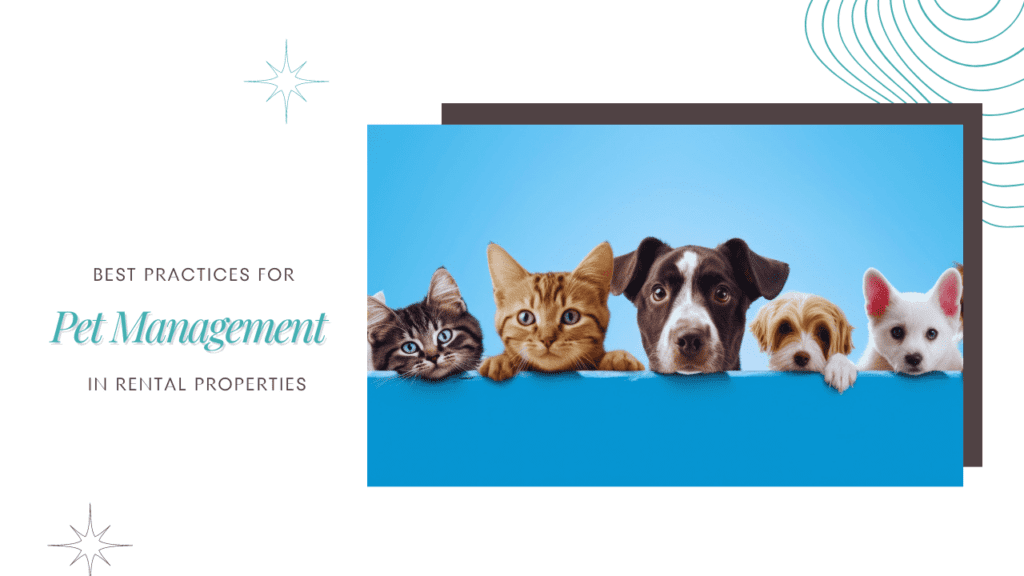
Pets come up a lot when we’re talking to owners and investors about their rental properties. Some landlords are immediately willing to accept pets; it’s never even a question. Others are absolutely against the idea of having other peoples’ pets roaming through their property and potentially causing damage. Most of the rental owners we work with aren’t quite sure what to do about pets; they appreciate the love that tenants have for their furry friends, but they also worry about liability and mess.
We’re wagging a few tails today, and talking to you about the best practices you can implement when it comes to managing pets in your rental properties. We think they’re generally a good idea as long as they’re screened and you have a strong pet policy in place.
Let’s take a look at how to protect your property without alienating more than half of your tenant pool.
Screening Pets Before You Allow Them
Fair housing laws dictate what you can and cannot ask when screening tenants.
Pets have no such protections. You can ask any questions you want. You can set any restrictions that make you feel better about allowing animals into your property.
Screening pets is a best practice that you should not avoid. Here are a few ways to do it:
- Require vet records
Talk to the pet’s vet of record, or request documentation from the vet that shows the pet is in good health. You want to be sure the dog or cat has been vaccinated and treated for fleas and ticks and been spayed or neutered. This will give you some extra peace of mind, and it will also demonstrate that the tenant cares about the animal and will take good care of it.
- Ask for references
Just like when checking references for a potential resident, you should also check references for their pets. Ask for the names and contact information of their current and past landlords. You can ask whether the pet was well-behaved, if any damage was left behind, and if any other tenants or neighbors complained about the pet. This will give you a better idea of how the pet has behaved in a rental setting in the past.
- Conduct a pet interview
Schedule a pet interview with the potential tenant and their furry roommate. This gives you a chance to see the pet’s temperament and behavior firsthand. Are they friendly, calm, and well-trained? Or do they seem nervous, aggressive, or destructive? An interview can also give you a chance to ask the owner about the pet’s routine, including feeding, exercise, and potty habits. This, too, will show you that the pet is well-cared for and an acceptable risk for your rental property. Take a photo of the pet for your records. If that pet passes away and your tenant gets a new pet, you’ll want to re-screen the new animal before allowing it, and photos will help you keep track of which pets you’ve actually met and approved.
Collecting a Pet Fee
Collecting a pet fee when your tenants move in is an excellent way to protect your property and increase your revenue.
When you decide to permit pets in your rental property, you have to consider the potential damage that could occur. Pets can harm the property, leave behind odors, and cause stains that may be expensive to clean and repair. By collecting a pet fee upon acceptance and before move-in, you can protect your property from unnecessary potential costs. A pet fee can cover the price of any damage your tenant’s pet causes to your property and help ensure your rental is kept in good condition moving forward.
Collecting a pet fee is also beneficial because it means you earn more on your rental property. The amount of the pet fee should be enough to cover any cleanup or repairs that may be required after a tenant’s pet has stayed in your rental. You should set the fee based on the rental market, location, and the type of pet you allow in your property.
The pet fee is in addition to your security deposit and is non-refundable. That means that if you don’t need to use the entire pet fee to clean or make repairs, it’s your money to keep.
Collecting a pet fee also increases the likelihood that you’ll keep your tenants in place for more than a single lease term. Tenants with pets are more likely to stay in place longer. That’s because if they move every year, they have to pay yet another pet fee when getting approved for a new property. This makes renewing their lease agreement with you more cost-effective. It saves you money on vacancy and turnover costs.
Charging a pet fee is a great way to earn more money, but it’s mostly about peace of mind. You’re increasing the liability that comes with renting out a property when you allow tenants to move in with pets. The collected fee can offset the cost of any damage or mess that the pet causes. This not only helps ensure that your rental remains in good condition, but it can also reduce the stress associated with owning a rental property. You know that you’ve done all you can to prevent future problems caused by pets.
Elements of a Strong Pet Policy
You know you’re going to screen any pet that wants to live in your property with their owner.
You know that you’re going to collect a pet fee that’s likely to protect you against any potential damage the pet causes.
What can you include in a pet policy to ensure you continue to protect the condition and value of your property while encouraging pet-owning tenants to apply for your property?
Establish some clear and fair standards for what you expect.
- Pet Policies Should Reference Types of Pets You Allow
In your pet policy, it’s essential to specify the types of pets allowed on the property. This can include dogs, cats, birds, fish, and reptiles. Make sure to also specify whether any breeds or species are not allowed. Check with your landlord policy; some of them will not cover so-called “dangerous breeds” such as Pit Bulls, Dobermans, and other large dogs. You can either restrict them altogether or require your tenant to purchase additional insurance to cover that liability.
- Pet Rent
We have already discussed and recommended that you collect a pet fee. You might want to collect pet rent as well. This is extra rent that’s paid every month to cover the animals who live there. In Florida, this could be anything from $20 to $50 per month, per pet. It’s another way to increase your revenue and protect yourself against potential damage.
- Establish Pet Rules
Your pet policy should outline the specific rules that tenants with pets must follow. This can include guidelines around pet noise, waste management, leash laws, and restrictions on the number of pets per unit. It should also clearly state your policy on pet visits, pet-sitting, and whether pets are allowed in communal areas in a multi-family rental property, such as hallways and elevators.
Your pet policy should explain how you will enforce the rules outlined in the policy. When you include the pet policy in your lease agreement, it becomes part of the tenant’s responsibility to follow those rules. If your resident violates the pet policy, they violate the lease agreement. This can ultimately lead to eviction.
It’s important to maintain clear communication with your tenants regarding the pet policy. Make sure to mention the policy to potential tenants, discuss it during the signing of the lease agreement, and provide them with a copy of it.
Allowing pets in your rental property can seem risky, but it’s usually a good idea. Not only do you open your property up to a larger pool of tenants, you have the potential to earn more money on that investment, as long as you have a strong pet policy and a dedicated screening process for the tenant’s pet.
These considerations are necessary for the well-being of your property and your own peace of mind. Conduct your pet screening, collect your pet fee, and create a pet policy that is comprehensive and fair. You’ll reap all of the benefits and reduce much of the risk.
After the tenant and their pet pass your screening and accept your terms, you’ll want to make sure that you give them a warm welcome to their new home. This is part of establishing a great landlord/tenant relationship. Provide them with a list of pet-friendly businesses in the area such as groomers, pet stores, and veterinarians. If your rental property is in an HOA, you’ll want to provide them with the separate HOA rules and regulations regarding pets, such as areas they are allowed to be in, and any pet waste pick-up policies.
 We’d love to help you have a good rental experience with tenants who have pets. If you have any questions about how to manage the dogs, cats, and other animals in your property, please reach out to us at Anchor Down Real Estate and Rentals.
We’d love to help you have a good rental experience with tenants who have pets. If you have any questions about how to manage the dogs, cats, and other animals in your property, please reach out to us at Anchor Down Real Estate and Rentals.
